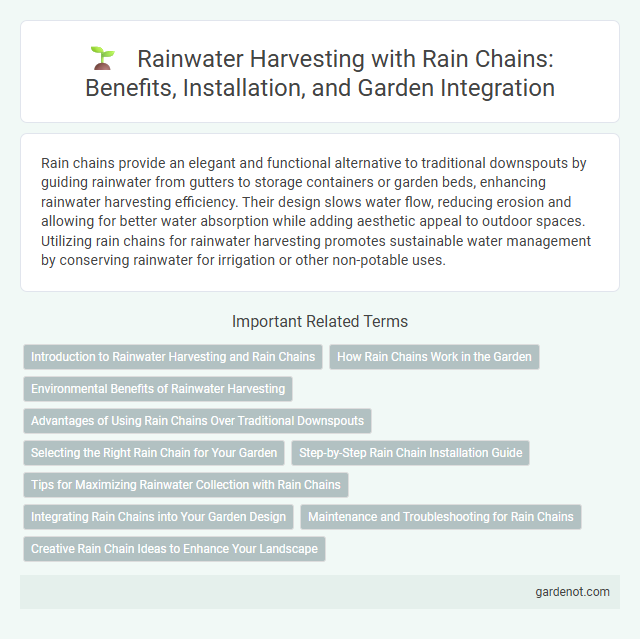Rain chains provide an elegant and functional alternative to traditional downspouts by guiding rainwater from gutters to storage containers or garden beds, enhancing rainwater harvesting efficiency. Their design slows water flow, reducing erosion and allowing for better water absorption while adding aesthetic appeal to outdoor spaces. Utilizing rain chains for rainwater harvesting promotes sustainable water management by conserving rainwater for irrigation or other non-potable uses.
Introduction to Rainwater Harvesting and Rain Chains
Rainwater harvesting captures and stores runoff from roofs for irrigation and other non-potable uses, reducing water bills and conserving resources. Rain chains serve as an aesthetically pleasing alternative to traditional downspouts, guiding water from the roof to ground-level containers or gardens. Made from materials like copper or aluminum, rain chains slow water flow while preventing soil erosion and minimizing splash damage.
How Rain Chains Work in the Garden
Rain chains guide rainwater from the roof to the ground or a collection container, channeling water without the need for traditional downspouts. As water flows down the linked cups or chains, it slows, reducing soil erosion and directing moisture efficiently to garden beds or rain barrels. By visually tracking the water's path, gardeners can monitor flow and optimize rainwater harvesting for irrigation and sustainable water management.
Environmental Benefits of Rainwater Harvesting
Rainwater harvesting using rain chains significantly reduces stormwater runoff, minimizing soil erosion and decreasing the burden on municipal drainage systems. This sustainable method conserves water by capturing and redirecting rainwater for landscape irrigation and groundwater replenishment. Implementing rain chains promotes eco-friendly water management, enhancing urban green spaces and contributing to biodiversity preservation.
Advantages of Using Rain Chains Over Traditional Downspouts
Rain chains offer an eco-friendly alternative to traditional downspouts by guiding rainwater gently from the roof to the ground or collection system, minimizing soil erosion and splash-back. They enhance water harvesting by slowing down water flow, allowing better absorption into rain barrels or garden beds. Visually appealing and easy to install, rain chains also reduce clogging issues common in conventional downspouts, ensuring efficient rainwater management.
Selecting the Right Rain Chain for Your Garden
Selecting the right rain chain for your garden involves considering materials such as copper, aluminum, or stainless steel for durability and aesthetic appeal. The size and length of the rain chain should match your roof's runoff capacity and garden layout to efficiently channel water toward your rainwater harvesting system. Choosing a rain chain with linked cups or funnels enhances water flow control and reduces splashing, optimizing the collection process in your garden.
Step-by-Step Rain Chain Installation Guide
Install a rain chain by first securely attaching the top ring or hook to the downspout outlet, ensuring it fits snugly to prevent water leakage. Next, connect each chain segment or cup in sequence, maintaining proper alignment for smooth water flow. Finally, position the bottom end over a drainage basin or rain barrel, anchoring it firmly to avoid movement during heavy rainfall.
Tips for Maximizing Rainwater Collection with Rain Chains
Position rain chains beneath downspouts to efficiently channel rainwater into barrels or containers for optimal collection. Use wide-mouthed rain barrels with secure lids to prevent evaporation and contamination, enhancing water retention. Regularly clean rain chains and gutters to maintain unobstructed water flow and maximize rainwater harvesting efficiency.
Integrating Rain Chains into Your Garden Design
Integrating rain chains into your garden design enhances rainwater harvesting by channeling water visually and functionally from rooftops to storage areas or plant beds. These decorative chains guide water flow gently, reducing erosion while adding aesthetic appeal through materials like copper or bamboo that complement natural garden elements. Utilizing rain chains promotes sustainable water management by efficiently directing collected rainwater to nourish your landscape and conserve resources.
Maintenance and Troubleshooting for Rain Chains
Regular maintenance of rain chains involves cleaning debris, such as leaves and dirt, to ensure unobstructed water flow and prevent clogging that can damage the chain or gutter system. Inspect rain chains frequently for rust, loose connectors, or damage to individual links, replacing parts as needed to maintain structural integrity and aesthetic appeal. Troubleshooting common issues includes realigning misdirected chains, securing loose attachments, and addressing overflow caused by improper installation or inadequate downspout compatibility.
Creative Rain Chain Ideas to Enhance Your Landscape
Creative rain chain ideas to enhance your landscape include installing copper rain chains for a rustic aesthetic that naturally patinas over time, adding decorative ceramic cups to guide water with vibrant colors and unique patterns, and incorporating LED lighting to illuminate water flow at night, creating a captivating visual feature. Positioning rain chains near Zen gardens or water features integrates functional rainwater harvesting with artistic landscaping, promoting sustainable water use and elevating outdoor decor. Combining different materials like glass, metal, and stone in rain chains can produce striking contrasts and textures that complement various landscape styles while efficiently directing rainwater.
Rainwater harvesting rain chain Infographic

 gardenot.com
gardenot.com